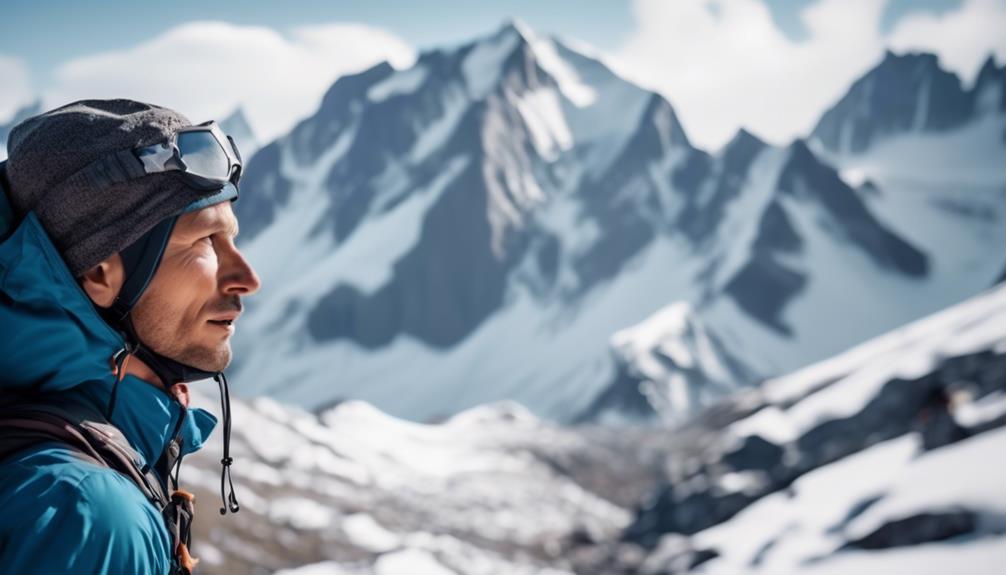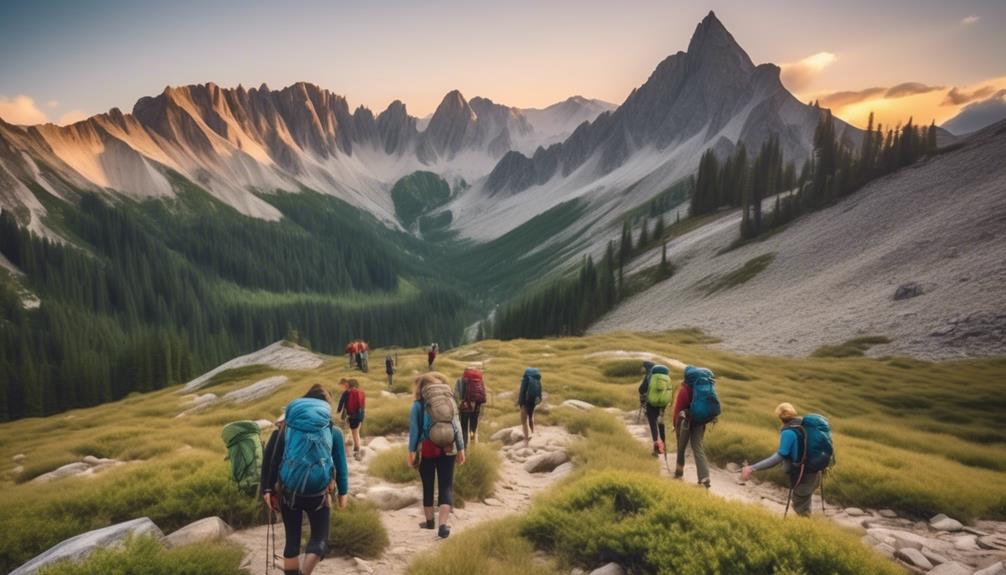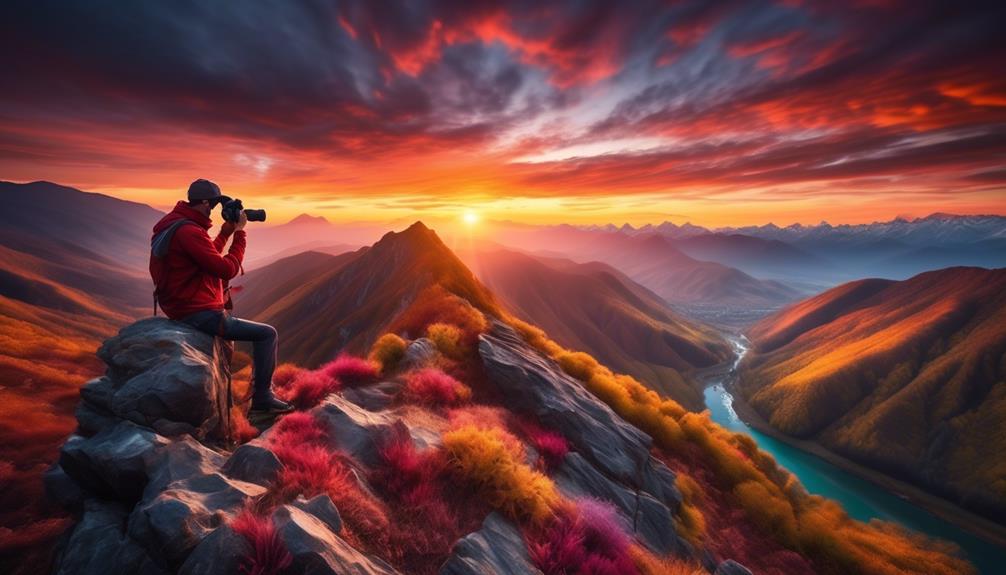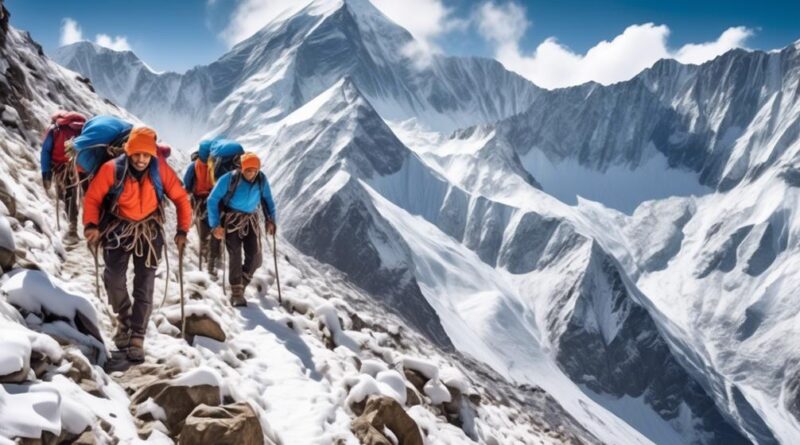Experience the Thrill: Extreme Mountain Trekking Adventures
You may think extreme mountain trekking is only for the most experienced and daring adventurers, but with the right preparation and mindset, it can be an exhilarating and achievable endeavor.
Picture yourself standing atop a rugged peak, surrounded by breathtaking vistas that few have the privilege to witness. The rush of conquering challenging terrain and pushing your limits is an experience like no other.
But before you embark on your journey, there are crucial factors to consider and essential tips to keep in mind. Whether you're a seasoned trekker or a novice looking for an adrenaline-fueled adventure, this discussion will provide you with valuable insights and practical advice to make your mountain trekking experience unforgettable.
Top 10 Mountain Trekking Destinations
When planning your next mountain trekking adventure, consider these top 10 destinations for an exhilarating and unforgettable experience. Among the peak summits and breathtaking views, the remote trails and untouched wilderness await your exploration.
One of the most renowned destinations for mountain trekking is the Himalayas. With its towering peaks and diverse landscapes, the Himalayas offer a challenging yet rewarding experience for trekkers of all levels. The Annapurna Circuit in Nepal is a must-visit, boasting panoramic views of the Annapurna and Dhaulagiri mountain ranges.
Another top destination is the Andes in South America, home to the iconic Inca Trail. This ancient pathway leads trekkers through a variety of stunning landscapes, including cloud forests and high-altitude mountain passes, ultimately culminating at the breathtaking Machu Picchu.
For those seeking remote trails and untouched wilderness, the Canadian Rockies provide an ideal setting. The West Coast Trail on Vancouver Island offers a rugged coastal trek with awe-inspiring ocean views and the chance to spot diverse wildlife along the way.
In Europe, the Tour du Mont Blanc offers a classic alpine trekking experience. This trail circumnavigates the Mont Blanc massif, showcasing the beauty of the French, Italian, and Swiss Alps with its dramatic peaks and lush meadows.
These top 10 destinations promise unforgettable mountain trekking adventures, each with its own unique blend of challenges and rewards. Whether you seek the thrill of conquering peak summits or the serenity of untouched wilderness, these destinations have something extraordinary to offer.
Essential Gear for Extreme Conditions
To navigate extreme conditions during mountain trekking, equip yourself with essential gear designed to ensure safety and comfort in challenging environments. When facing cold weather and testing your survival skills, the right equipment can make all the difference. Here are some must-have items to prepare you for extreme mountain trekking:
- Insulated Clothing: Invest in high-quality, insulated clothing designed for cold weather conditions. This includes a waterproof and windproof jacket, thermal base layers, and insulated pants to keep you warm and dry in harsh climates.
- Emergency Shelter: Carry a lightweight and durable emergency shelter, such as a compact tent or bivy sack, to protect yourself from the elements in case of unexpected situations or overnight stays.
- Navigation Tools: Ensure you have reliable navigation tools, such as a GPS device, compass, and detailed topographic maps. These tools are essential for staying on course and finding your way in challenging terrain.
- Survival Kit: Pack a comprehensive survival kit containing essential items like a multi-tool, fire starter, first-aid supplies, emergency blanket, and high-calorie food rations. These tools can be lifesaving in emergency situations and provide peace of mind during your trek.
Training Tips for High Altitude Trekking

Preparing for high altitude trekking requires a focused training regimen to acclimate your body to the reduced oxygen levels and strenuous conditions you'll encounter.
Altitude acclimatization is crucial for your body to adjust to the lower oxygen levels at higher altitudes. It's recommended to gradually increase your altitude exposure during training to allow your body to adapt. Incorporating hikes at increasing elevations into your training schedule will help prepare your body for the challenges of high altitude trekking.
Proper hydration techniques are essential for high altitude trekking. Dehydration can exacerbate the symptoms of altitude sickness, so it's important to maintain proper hydration levels throughout your training and trek.
During your training, focus on practicing good hydration habits, such as drinking plenty of water and electrolyte-rich fluids. Additionally, familiarize yourself with the signs of dehydration and altitude sickness, so you can recognize and address these issues promptly.
Incorporate interval training into your regimen to improve cardiovascular endurance, as trekking at high altitudes can be physically demanding. High-intensity interval training and aerobic exercises can help improve your body's ability to cope with the reduced oxygen levels you'll encounter during high altitude trekking.
It's important to listen to your body during training and make adjustments as needed to ensure you're adequately prepared for the challenges of trekking at high altitudes.
Safety Precautions for Alpine Adventures
Before embarking on alpine adventures, familiarize yourself with essential safety precautions to ensure a secure and enjoyable trekking experience.
- High Altitude First Aid: Acquaint yourself with the symptoms and treatment of altitude sickness. Carry necessary medications, such as acetazolamide, and be prepared to descend if symptoms worsen. Additionally, learn about the signs of high altitude pulmonary edema (HAPE) and high altitude cerebral edema (HACE) and know how to respond in case of an emergency.
- Weather Preparedness: Check weather forecasts before setting out and be prepared for sudden changes in weather conditions. Pack appropriate clothing layers, including waterproof and windproof outer layers, to protect against the elements. Always carry extra food, water, and emergency supplies in case of unexpected delays or adverse weather.
- Navigation Skills: Familiarize yourself with the route using maps, GPS, or guidebooks. Carry a compass and know how to use it, especially in low visibility conditions. Understanding the terrain and having a detailed itinerary can help prevent getting lost.
- Emergency Communication: Carry a fully charged mobile phone or emergency communication device. Make sure to inform someone of your trekking plans and expected return time. In case of an emergency, knowing how to signal for help or use emergency communication equipment is crucial.
Best Practices for Leave No Trace Trekking

Once you've ensured your safety and prepared for changing weather conditions, it's essential to also practice leave no trace trekking to minimize your environmental impact and preserve the natural beauty of the mountains. When trekking in the mountains, it's crucial to follow best practices for leave no trace trekking to ensure minimal impact and environmental conservation.
Start by planning ahead and preparing accordingly. Pack reusable containers for food and drinks, and avoid bringing single-use plastics. Carry out all your trash, including food scraps, to maintain the pristine environment. When nature calls, make sure to do your business at least 200 feet away from water sources and pack out all toilet paper and hygiene products. This ensures that the area remains clean and undisturbed.
When setting up camp, choose durable surfaces and avoid trampling on vegetation. Keep your campsite small and refrain from building new fire rings or altering the landscape. Use established fire rings if permitted and ensure to fully extinguish fires before leaving. Additionally, respect wildlife by observing from a distance and not feeding them.
Stay on designated trails to avoid causing unnecessary damage to the surrounding flora and fauna. When encountering obstacles, navigate through them without causing harm to the environment.
Navigating Challenging Terrain: Expert Tips
When navigating challenging terrain during mountain trekking adventures, it's crucial to maintain a steady pace and scan the path ahead for potential obstacles. To ensure a safe and successful journey, here are some expert tips to help you navigate challenging mountain terrain:
- Survival Skills: In challenging terrain, it's essential to have a solid understanding of survival skills. This includes knowledge of building shelters, finding and purifying water sources, and identifying edible plants. Carrying essential survival gear such as a first aid kit, emergency blanket, and fire-starting tools is also crucial.
- Route Planning: Before embarking on your trek, thoroughly research and plan your route. Take into account the terrain, weather conditions, and potential obstacles. Familiarize yourself with topographic maps and use GPS devices to stay on track. It's also wise to have a backup plan in case unexpected challenges arise.
- Staying Focused: When navigating challenging terrain, it's easy to become overwhelmed. Stay focused on the task at hand and maintain a positive mindset. Keep a lookout for trail markers, natural landmarks, and signs of animal activity to stay oriented.
- Adaptability: Be prepared to adapt to changing conditions. Weather, trail obstructions, and other unforeseen circumstances may require you to adjust your route or pace. Flexibility and quick thinking are key to overcoming obstacles in challenging terrain.
Capturing Breathtaking Views: Photography Tips

To capture breathtaking views during your mountain trekking adventures, employ photography techniques that enhance the natural beauty of the landscape. When capturing mountainous landscapes, consider the rule of thirds. Frame your shot by mentally dividing the image into nine equal parts with two horizontal and two vertical lines. Position the horizon on the upper or lower horizontal line to create a visually appealing composition. Experiment with different angles to find the most captivating perspective. Sometimes getting low to the ground or finding a higher vantage point can make a significant difference in your photographs.
Lighting is crucial in photography, especially when capturing mountain scenery. The golden hours—shortly after sunrise and just before sunset—offer soft, warm light that can add depth and dimension to your images. During midday, when the sun is harsh, look for interesting shadows and textures. Additionally, using a polarizing filter can help reduce glare and enhance the colors of the sky and surrounding landscape.
When composing your shots, include elements that provide scale and context. Incorporating a person, a tent, or a nearby tree can help convey the grandeur of the mountains. Leading lines, such as a winding trail or a meandering river, can draw the viewer's eye into the scene, adding depth and interest to your photographs.
Sustainable Travel: Eco-Friendly Practices
As you embark on your mountain trekking adventures, incorporating sustainable travel practices and eco-friendly initiatives can further enhance your experience while preserving the natural beauty of these landscapes. When you prioritize green travel and conservation efforts, you not only minimize your environmental impact but also contribute to the long-term preservation of these stunning mountain environments.
Here are some eco-friendly practices to consider as you plan your next trekking expedition:
- Pack Light: Opt for lightweight, multi-purpose gear to reduce the energy expended in carrying heavy loads and minimize your carbon footprint.
- Leave No Trace: Adhere to the principles of 'Leave No Trace' by disposing of waste responsibly, minimizing campfire impacts, and respecting wildlife habitats.
- Choose Responsible Tour Operators: Select tour operators that prioritize sustainability, support local communities, and implement eco-friendly practices in their operations.
- Support Conservation Efforts: Contribute to local conservation organizations or participate in volunteer programs aimed at preserving the natural ecosystems and wildlife of the mountains.
Frequently Asked Questions
Are There Any Age Restrictions for Extreme Mountain Trekking Adventures?
Yes, there are age restrictions for extreme mountain trekking adventures. They are in place to ensure the safety of all participants and to account for the physical fitness limitations that may arise with age.
How Do Extreme Weather Conditions Affect Mountain Trekking Experiences and Safety?
When extreme weather hits, gear prep and survival skills are crucial for mountain trekking. Altitude sickness and emergencies require quick response. Stay informed, plan ahead, and always prioritize safety to make the most of your adventure.
What Are the Risks and Precautions for Encountering Wildlife During Mountain Trekking?
When encountering wildlife during mountain trekking, it's crucial to stay alert and follow safety precautions. Be mindful of your surroundings, keep a safe distance, and avoid provoking or approaching wild animals to ensure a safe and enjoyable adventure.
Are There Any Specific Cultural Considerations or Etiquette to Be Aware of When Trekking in Remote Mountain Regions?
When trekking in remote mountain regions, it's important to be mindful of cultural customs and respectful interactions. Research local traditions, dress modestly, and ask permission before taking photos. Respect wildlife and sacred sites, and be open to learning from the local community.
How Do Trekkers Handle Waste Disposal and Sanitation in Remote Mountain Environments?
When trekking in remote mountain regions, it's crucial to practice responsible waste management and sanitation practices. Pack out all trash, use biodegradable soap, and follow designated bathroom procedures. Leave no trace and preserve the natural beauty for future adventurers.
Conclusion
Now that you've learned about the top mountain trekking destinations, essential gear, training tips, safety precautions, best practices, expert navigation tips, photography tips, and sustainable travel practices.
You're ready to experience the thrill of extreme mountain trekking adventures.
Remember to always be prepared, stay safe, and leave no trace as you explore the breathtaking views and challenging terrain of the mountains.
Get ready for an unforgettable adventure!
